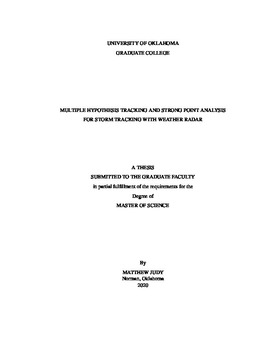| dc.contributor.advisor | Yu, Tian-You | |
| dc.contributor.author | Judy, Matthew | |
| dc.date.accessioned | 2020-02-18T14:53:35Z | |
| dc.date.available | 2020-02-18T14:53:35Z | |
| dc.date.issued | 2020-05-08 | |
| dc.identifier.uri | https://hdl.handle.net/11244/323757 | |
| dc.description.abstract | Storm tracking using radar observations of weather is a valuable tool both for the study of weather conditions and for the issuance of advance warning when such conditions are severe. Centroid-based storm tracking algorithms are a common tool used to provide short-term forecasting of storms. In these algorithms, cells representing intense areas of storms are identified. The cells are compared to cells identified at regular intervals, and similar cells are assigned to tracks which indicate the history of the underlying storm. These tracks may then be used to generate forecasts. The Strong Point Analysis, Multiple Hypothesis Tracking (SPA-MHT) technique is a centroid-based algorithm which draws on methods effective in storm tracking and in the more general field of object tracking. Strong Point Analysis identifies storm cells using the erosion and dilation operations from the field of mathematical morphology. Multiple Hypothesis Tracking assigns these cells to tracks, resolving ambiguities by incorporating data from multiple sequential sets of observations.
In this thesis, the motivation for the design of SPA-MHT is presented in the context of previous storm tracking algorithms. The suitability of Strong Point Analysis for storm identification and Multiple Hypothesis Tracking for track association is considered. An implementation of each technique is also presented. The combined implementation is evaluated on radar data from the NEXRAD network of Doppler weather radars. This constitutes the first evaluation of Multiple Hypothesis Tracking on actual weather radar data. Both qualitative visual comparisons and quantitative comparisons are considered. SPA-MHT is found to outperform the current NEXRAD tracking algorithm when tracking storms that are isolated or forming clusters, but performance between the two methods is more comparable in challenging situations such as squall lines. | en_US |
| dc.language | en_US | en_US |
| dc.subject | Computer Science. | en_US |
| dc.subject | Weather Radar. | en_US |
| dc.subject | Meteorology. | en_US |
| dc.title | MULTIPLE HYPOTHESIS TRACKING AND STRONG POINT ANALYSIS FOR STORM TRACKING WITH WEATHER RADAR | en_US |
| dc.contributor.committeeMember | Cheong, Boon Leng | |
| dc.contributor.committeeMember | Yeary, Mark | |
| dc.date.manuscript | 2020-02 | |
| dc.thesis.degree | Master of Science | en_US |
| ou.group | Gallogly College of Engineering::School of Electrical and Computer Engineering | en_US |
